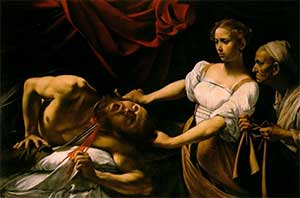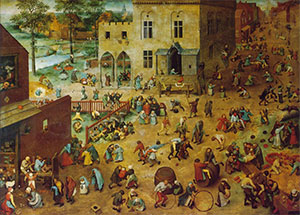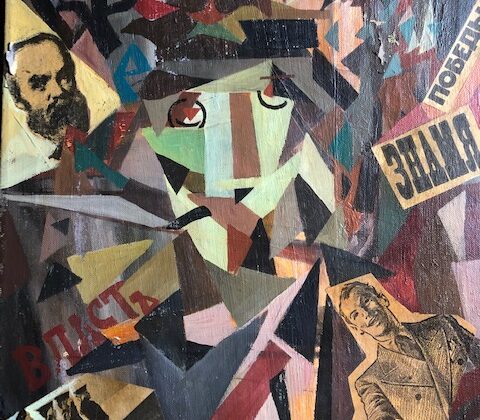Artemisia Gentileschi, leading female painter and female rights leader
By Francesco Carelli , University of Milan
Two women are holding a man down on a bed. One presses her fist against his head, so he can’t raise it from the mattress, while her companion pins his torso in place. They are well-built with powerful arms but even so it takes their combined strength to keep their victim immobilised as one of them cuts through his throat with a sword. Blood spurts from deep red geysers as she saws. Her victim’s eyes are wide open. He knows exactly what is happening to him.

The dying man is Holofernes, an enemy of the Israelites in the Old Testament, and the young woman beheading him is Judith, his divinely appointed assassin. Yet at the same time he is also an Italian painter called Agostino Tassi, while the woman with the sword is Artemisia Gentileschi, who painted this. It is, effectively, a self-portrait.
Two big, blood-drenched paintings of Judith and Holofernes by Gentileschi survive, one in the Capodimonte in Naples, the other in the Uffizi in Florence. They are almost identical except for small details – in Naples Judith’s dress is blue, in Florence yellow – as if this image was a nightmare she kept having, the final act to a tragedy endlessly replaying in her head.
With words and images, she fought back against the male violence that dominated her world.PreviousNext
Artemisia Gentileschi, presented at National Gallery in London, is probably one of the most famous female painters from the 17th century and perhaps one of the most celebrated painters of the generation after Caravaggio. This Italian painter is one of the first female artists to gain recognition in the Baroque era and she is definitely one of the most discussed figures from the 17th century today, not only because of her artistic accomplishments but also for controversies which followed her life. She was definitely one of those artists ahead of her time and her work and biography were featured in many recent publications, although it is sometimes difficult to make a distinction between facts about Artemisia Gentileschi and those fictional elements and mythical narratives woven around her personality. She was one of the first female artists to stand up for women’s rights and to prepare the way for future feminist authors. With words and images, she fought back against the male violence that dominated her world.PreviousNext
Artemisia Gentileschi was born in Rome in the last decade of 16th century. She was the daughter of a notable painter Orazio Gentileschi, highly influenced by the Caravaggio painting style which became the dominant in the Artemisia’s work as well, in her highly naturalistic portrayal of figures, dramatic scenes and the use of chiaroscuro technique. She was the first female painter who became a member of Accademia di Arte del Disegno in Florence and it was a major success at that time when art studies were inaccessible to women. With her highly distinguishable style, she quickly gained praise among her contemporaries but throughout the history her artistic achievements were usually overshadowed by her rape trauma and the prosecution which followed. In those centuries after her death, she became a feminist legend. Her success as a woman painter, and early women empowerment tendencies in her works, were often emphasized more than the artistic quality and aesthetic value of her paintings.
When it comes to the artistry of Artemisia Gentileschi the first associations are those strong women protagonists often inspired by the characters from the Bible. In the patriarchal society with male-dominated values, women portrayed by Gentileschi appeared as unorthodox, transgressing the stereotypes of gender roles. Often violent scenes depicted by Gentileschi feature strong, vigorous women, warriors or victims, but never delicate, idealized, sensual figures. Her empowered female protagonists, familiar to blood and violence, are often interpreted, like her oeuvre in whole, as a revenge for the rape and traumatic experience she survived. Agostino Tassi, the man responsible for the sexual assault was a colleague of her father Orazio and the tutor of Artemisia. He was imprisoned twice for similar crimes, before he was prosecuted by Artemisia’s father. This incident later became the crucial point of view when it comes to the understanding of Gentileschi’s oeuvre and it also initiated the feminist view of her artistic practice.
Until the last couple of decades, Artemisia Gentileschi was seen as a curiosity rather than anything else. Her life, including rape trauma, trial, and forced marriage came to be the often explored themes in many fictional and non-fictional works. She was a friend of Galileo Galilei as they both had connections to the Grand Ducal Court in Florence and were members of the Academia del Disegno.
Although Artemisia’s art was neglected and forgotten after her death and two centuries had to pass before the rediscovery of her oeuvre, the historical and artistic significance of Artemisia Gentileschi cannot be denied. After all, she was one of the leading painters of her time, confident and self-conscious about her personal life and her artistry. But it isn’t until recently that she became one of the most important feminist role-models, person portrayed in many popular works of novelists and filmmakers, and recognized outside the closed circles of scholars and art historians.
Almost every household has an unsolved Rubiks Cube but you can easily solve it learning a few algorithms.



